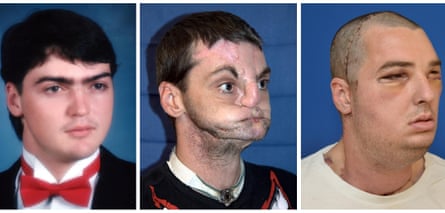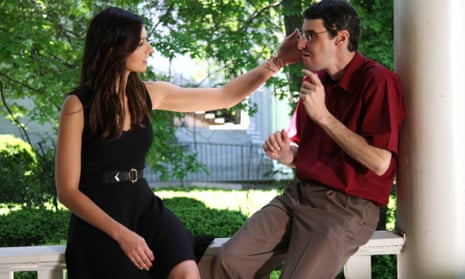A woman has met the man who received the face of her dead brother in a groundbreaking transplant.
Rebekah Aversano saw – and touched – the transplanted face for the first time in an emotional meeting with Richard Norris, who was severely disfigured in a shooting accident.
The encounter was filmed by 60 Minutes Australia and will be broadcast this weekend.
Aversano’s brother Joshua, 21, was run over and killed by a minivan while crossing the street three years ago. His family, from Maryland, donated his face to Norris.
The Virginia man had undergone dozens of conventional operations to try to repair damage from the shooting accident in 1997, when he was 22. They had limited success, leaving him depressed and suicidal.
The Aversano family’s donation gave him another chance. In one of the most complex face transplants in history, a team at the University of Maryland medical centre took 36 hours in March 2012 to transplant teeth, a jaw, tongue muscles and nerves.
Norris, now 39, thanked Rebekah in a meeting at his home in Virginia. Reaching out her hand, she asked: “Do you mind if I touch it?” After doing so she stepped back, astonished: “Wow, this is the face I grew up with.”

Joshua’s mother, Gwen, told Canada’s CTV News network the family knew the donation was the right thing to do.
“We can definitely see our son in him,” she said. “Some of the facial features would definitely be our son, so we could see similarities, very much so. We are just so pleased we have been able to help him. Even though we had such a tragic loss, we were able to give someone else the benefit of our son.”
Norris said that before the transplant he lived through hell, venturing out at night to minimise contact with people and wearing masks to disguise the horrific injuries caused by an accidentally self-inflicted shotgun blast. “I’ve heard all kinds of remarks. A lot of them were really horrible,” he said.
He chose to have the transplant even though doctors gave him only a 50% chance of survival.
The doctor who performed the operation, Eduardo Rodriguez, said Norris took on an enormous responsibility because his body will always regard the new face as a foreign object, prompting attacks by his immune system.
Norris cannot drink, smoke or get sunburned and must take a cocktail of anti-rejection drugs for the rest of his life.
A naval research grant intended to help wounded military veterans partly funded the operation.
Doctors in France performed the world’s first partial face transplant in France in 2005 on a woman who was mauled by her dog. Of 27 subsequent face transplants, four recipients have died.

Comments (…)
Sign in or create your Guardian account to join the discussion